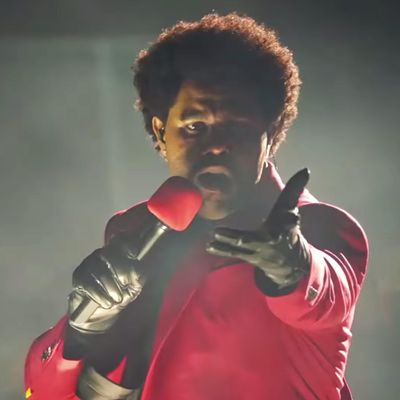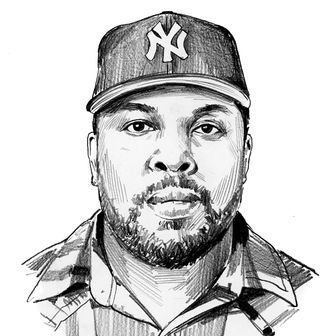
Drama is the beating heart of MTV’s Video Music Awards, a show whose most memorable moments have come out of plopping an unusual cast of characters in the same room with drinks and entertainment and luxuriating in the chaos the mix of big egos and beef produces. The cast delivered, from Nirvana clowning Guns N’ Roses singer, Axl Rose, onstage at the 1992 show, to the awkward exchange between Courtney Love and Madonna during the 1995 preshow, to Diana Ross jiggling Lil’ Kim’s breast while a wobbly Mary J. Blige watched in 1999, to Taylor Swift and Kanye West’s showdown in 2009. As the cable channel eased off its role as a mover and shaker in music — and reruns of Ridiculousness, Teen Mom, and Catfish usurped the lengthy blocks of videos the network built its reputation on — the VMA broadcast has become a game of catch-up and a reminder that MTV hasn’t entirely forgotten what the M in the name stands for.
In a pandemic, the madcap artist interactions and shady crowd reaction shots that help to make the VMAs must-see TV in a normal year are simply not possible, but freed from the obligation of hosting a live show in a packed room, the show presented a chance to return to the essence of stylish performance clips that powered the network’s early years and reconnect MTV to its roots. The 2020 VMAs made a noble attempt at staging a seamless virtual awards show and notched a few notable artist showcases but otherwise felt a little out of step with the dynamic range of mainstream music in 2020 and the seriousness of this moment in history. Where to begin? It’s great to see K-pop and reggaeton artists get shine in the broadcast. BTS’s VMA debut was long overdue, and the night’s performance of “Dynamite” caught the group as its visual aesthetic seems most refined and its music starts to make inroads on English-speaking listeners. Maluma was a prince; the medley of artists performing J Balvin’s “Mi Gente” all over New York City was electric. (Balvin pulled out of an intended appearance and felt notably absent, though this was sweet consolation.)
That said, the list of performers skewed heavily toward big pop hits, leaving DaBaby as the lone trap artist — Roddy Ricch dropped out as well — and the Weeknd’s synth-pop jam “Blinding Lights” and host Keke Palmer’s minor New Zealand chart hit, “Snack,” repping for R&B. In a shocking reversal of fate, the rock awards were kicked from the main broadcast, leaving Travis Barker’s spot presenting “Best Hip-Hop” and introducing the “In Memoriam” segment as the night’s rare reminders that rock and roll still exists. (The “In Memoriam” segment, to be fair, named Little Richard … but it forgot John Prine and Justin Townes Earle. Country doesn’t really exist in this broadcast either.) Really, the VMAs were a pop-star pageant, and the girls delivered. Doja Cat paid homage to the old MTV News spots and staged a sure-footed routine that looked like a colorful video-game boss fight. Lady Gaga was as present last night as Palmer was; Mother Monster took home five moonpeople, including Artist of the Year and the new Tricon Award, which celebrates artists who made an impact over three different decades. (No shade, but this is an odd way to honor an artist only 12 years removed from her debut album. Video Vanguard made more sense. The VMAs have problems naming things now. Maluma and J Balvin won Best Latin. Just say “song”!) Gaga treated her acceptance speeches like a pandemic fashion show, and later in the Chromatica medley, she threw her gay fans a bone opening with the much-memed “Chromatica II”/“911” segue and blasting through the album’s hit singles.
It didn’t all go smoothly. The show purported to celebrate New York City, but the only living New York artist given more than a couple seconds to shine was Gaga. The Weeknd’s surprise firework display on the Hudson River riled up locals who weren’t tipped off about explosions Thursday night. JP Saxe and Julia Michaels passed the Two Daughters Diner in their gorgeous duet of “If the World Was Ending.” The location exists only in the imaginary NYC of Brooklyn Nine-Nine, a show shot on a lot in Studio City out west. (Did BTS really shut down Dumbo for “Dynamite”?) With no Brooklyn drill or Bronx Latin trap artists performing, and with presentations happening against a CGI rendering of the Manhattan skyline with applauding audience members appearing wraithlike as Star Wars holograms, it was maybe better to ditch the pretense of a hub city entirely. Swift and Megan Thee Stallion didn’t even bother dressing up. There was no need to try to lull the viewer into a sense of normalcy. Everyone’s wise to the elephant in the room.
The Black Eyed Peas closed the show inexplicably thrusting light-up codpieces at the camera in a medley of “Vida Loca,” a single built on parts from Major Lazer’s “Pon de Floor” and MC Hammer’s “U Can’t Touch This,” and “I Gotta Feeling.” The puzzling choice of a closer typified the disconnect between this show and the overarching summer it’s meant to address. The show seemed unsure of how dark to go, whether or not the audience needed colorful abstraction or tasteful activism. The abstraction worked. Miley Cyrus looked and sounded great channeling the pantheon of early ’80s pop-rock singers her new single, “Midnight Sky,” pulls from. (See: Stevie Nicks, specifically from The Wild Heart; the Pat Benatar theme from The Legend of Billie Jean; borderline-ice-blonde ’do Cherie Currie rocked in the Runaways.) Chloe x Halle dazzled in the preshow with “Ungodly Hour.” (Jail for the executive who didn’t think this was main-stage material.) Social-justice messaging felt like an afterthought, and that’s unfortunate in a year in which the BET Awards wowed with a broadcast that was serious without being overbearing, and even the Democratic National Convention successfully mixed current events with modern music, Billy Porter debacle notwithstanding. This 2020 VMAs had good intentions and good performances but didn’t quite capture the pulse of an eventful year in music beyond the biggest chart sensations, although, in the end, the night did come out looking like a killer pop-video block. In a way, that’s restoring the feeling.


